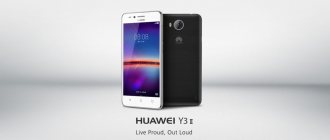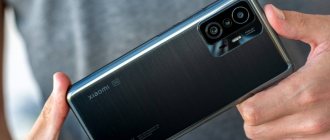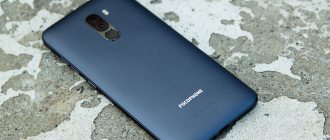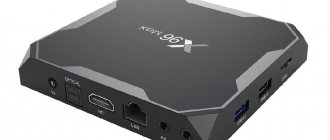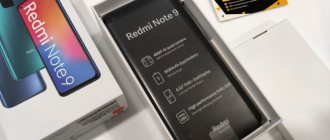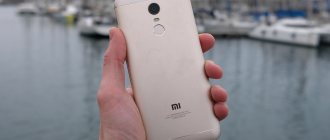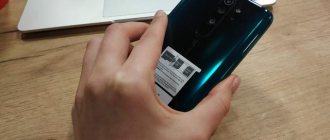Appearance Features
The design uses only three colors: dark gray, orange and blue. The back cover is made of textured plastic, which is highly resistant to slipping. A certain disadvantage of this texture is that the surface is more susceptible to contamination. But there is also a significant plus - traces from hand touches on it will not be noticeable at all.
A fingerprint scanner is located in the central part of the back cover. It was decided to send the main camera modules to the left side of the rear surface. A new trend can be seen in their design: a square block with rounded edges. Along with the photomodules, it also houses a single LED flash.
The Redmi 9C does not have an infrared module, so you won’t be able to use the phone as a remote control.
Components of the Xiaomi Redmi 9C smartphone
The smartphone comes in a standard white box made of thick cardboard. The front side shows the device itself and its name.
On the side of the box there is a sticker with basic information about the smartphone, IMEI, and disposal method.
A microUSB cable and a power supply are supplied in the box with the device.
The smartphone supports 10 W fast charging, and the manufacturer included a fast charging unit in the box; you don’t have to buy it separately.
Screen quality
The resolution of the 6.53-inch display is 720x1600 pixels, so you can’t expect high-quality images from it in any lighting conditions. Brightness drops noticeably in bright sunlight, and colors are a little dull compared to the color palette of the AMOLED matrix. The NTSC color gamut coverage is 70%, which is an average result.
Standard options for adjusting color temperature, selecting reading modes, “night”, “day”, etc. are available. It was decided to place the front photo module in the central part of the screen in the form of a classic teardrop-shaped cutout. The frames turned out to be quite narrow, so the aspect ratio reached a good 20:9. Anti-blue light technology significantly reduces the strain on the visual system.
Display
The display is based on an IPS matrix and shows true colors, which has a positive effect on the overall image quality. Problems are observed only with black color, which is more like dark gray. This is a feature of the IPS matrix, it is not the manufacturer’s fault.
The density of 269 PPI allows you to get the most uniform image possible. The brightness of 400 nits is enough even for working in direct sunlight. HD+ resolution allows you to enjoy the clearest picture in almost any conditions.
On the 6.53-inch diagonal screen, you can easily see even small details. The display is protected by 2.5D tempered glass. It has a high-quality oleophobic layer, as well as an anti-reflective coating.
The Redmi 9C NFC screen refresh rate is 60Hz. This is a standard indicator, which is not bad. After all, a frequency of 120 Hz and higher would quickly consume the smartphone’s battery power.
The standard tint setting is set to slightly cooler tones. You can increase saturation programmatically using the appropriate settings in MIUI 12.
| Screen resolution | 720 x 1600 pixels |
| Diagonal | 6.53″ (16.59 cm) |
| Type | IPS LCD |
| Aspect Ratio | 20:9 |
| Pixel Density | 269 dots per inch (ppi) |
| Update frequency | 60 Hz |
| Maximum brightness | 405 Nit |
| Screen protection | Strained glass |
| Screen to body ratio | 81,1% |
| Color rendition | 16 million colors |
| Frameless screen | Yes |
| HDR support | No |
Photography Level
The budget phone Redmi 9C was equipped with 3 photo sensors, which significantly distinguishes it from its competitors. The resolution of the first sensor is 13 megapixels with an f/2.2 aperture. The second sensor has a resolution of 2 megapixels with an f/2.4 aperture. It is needed to create blur when shooting portraits, which allows you to focus only on the subject's face.
The range of software features is quite modest: phase detection autofocus with HDR, artificial intelligence technology for portrait and other modes, and face recognition. Accordingly, you can unlock the device by face. A popular option called “Kaleidoscope” has also appeared.
Video files are recorded in two formats: 1080p and 720p, and at the same speed of 30 fps.
For taking selfies, a 5-megapixel camera with a pixel size of 1.12 microns and an f/2.2 aperture has been developed. It also implements an artificial intelligence function for determining scene settings, HDR, and enhancement system 5.0. Options for shooting timer, face recognition, and palm release have been added. Due to the absence of a front flash, the display itself is used for illumination.
Battery
The Redmi 9C NFC battery has a capacity of 5000 mAh, the smartphone easily works for several days without the need to recharge. In talk mode over a 3G network, the phone lasts up to 26 and a half hours - this is a pretty impressive result. This was achieved using all components of the hardware platform, not just the battery.
In addition, the MIUI 12 operating system can work normally with the smartphone’s battery. The developers managed to optimize Android and make it work better. Hence the battery life.
There is no support for fast charging in the smartphone because it still uses a microUSB port instead of USB Type-C. You can speed up the charging process a little by connecting your smartphone to a 10-watt charger. However, you will have to purchase it separately, since it is not included in the package.
It is worth noting that the smartphone copes well with video production. When viewing at maximum screen brightness, the battery will be completely drained in 14 hours - this is an excellent result for a budget phone.
| Battery capacity | 5000 mAh |
| Battery type | Lithium polymer (Li-pol) |
| Fast charging | No |
| Wireless charger | No |
| Reverse charging | No |
| Full charge time | 179 minutes |
| Talk time | 26.5 hours |
| Working hours when surfing the Internet | 18 hours |
| Operating time when watching video | 14 hours |
Performance Metrics
Redmi 9C NFC using AnTuTu demonstrates excellent performance for a public sector employee (109,000 benchmarks), which is slightly less than that of a similar modification - the Xiaomi Redmi 9 smartphone. The new product is equipped with a MediaTek Helio G35 processor, which is developed using a 12 nm process technology. The maximum core frequency of the A53 reaches 2.3 GHz, and the PowerVR 8320 graphics accelerator accelerates to 680 MHz. This is enough to confidently play entry-level and intermediate-level games. HyperEngine technology is implemented for smooth and responsive gameplay. Its tasks also include ensuring realistic graphics.
LPDDR4X RAM is available in two versions - 2 and 3 gigabytes. eMMC 5.1 memory of 32 and 64 GB is used as built-in storage.
The advantages of the device include the presence of an NFC chip, which allows you to make contactless payments via Google Pay. Wireless data transfer is carried out via Bluetooth 5.0 and 2.4G Wi-Fi, support for 802.11 b/g/n protocols is organized.
Accurate location determination on the ground is the task assigned to four geomodules AGPS, GPS, Beidou and GLONASS.
Sound and multimedia
An interesting feature of the smartphone is the presence of a 3.5 mm jack for connecting wired headphones. Nowadays you can’t find it in all phones. You can easily connect your favorite studio monitors to the device and enjoy high-quality sound.
The Redmi 9C NFC has only one speaker, and the sound is quite clear, without any extraneous wheezing. Even at maximum volume there is no crackling noise.
The volume reserve is such that the call can be heard even in the subway or in the middle of a noisy street during rush hour. There is also an FM radio that allows you to listen to online radio stations in digital format.
Playing supported audio and video formats is possible even using a standard player integrated into the MIUI shell. Even audio formats are supported without loss of quality.
| Speakers | Mono |
| 3.5 mm jack | Yes |
| FM radio | Yes |
| Dolby Atmos | No |
| Sound formats | MP3, FLAC, WAV, M4A, APE, AAC, OGG Vorbis, AMR |
| Video formats | MP4, MKV, AVI, 3GP, WEBM, ASF |
Technical specifications
| Screen | 6.53”, Dot Drop, 720x1600 |
| CPU | MediaTek Helio G35 |
| Graphics accelerator | PowerVR 8320 |
| RAM, GB | 2/3 |
| ROM, GB | 32/64 |
| Main camera, MP | 12+2 |
| Front camera, MR | 5 |
| Battery, mAh | 5000 |
| NFC | Eat |
| price, rub. | From 9800 |
Shirik
The third 16 MP camera is responsible for shooting a wide angle of 117°. The focal length is 17 mm. For comparison, let's look at examples from all three cameras at once.
16 MP
12 MP
12 MP – 2x zoom
Portrait photography
Traditionally the weakest mode for Xiaomi devices, in the case of Mi 9 it has reached a new level. For example, you can finally remove facial decoration when shooting with bokeh effect. By the way, the blur level can be adjusted within f/1.0 - f/16, and even after shooting, already in the Gallery.
f/1.8
f/1.0
Night photography
Doesn't boggle the mind. Now every flagship considers it its duty to upgrade this particular parameter. And Xiaomi is silent here, simply equipping its top-end devices with good cameras - far from the best on the market in terms of night photography.
12 MP
48 MP
12 MP
48 MP
Yes, there is a night mode with high shutter speed. You can shoot handheld, without a tripod. At the end of the day, we get slightly overexposed photographs with too high a contrast.
General impression
The characteristics of the Xiaomi Redmi 9C turned out to be quite interesting for a representative of the budget segment of mobile devices. Its advantages include the presence of a fingerprint scanner, an NFC module for contactless payment and a capacious battery.
The model demonstrates good performance, which is enough to perform everyday tasks without freezing or stuttering. You shouldn't expect high photo quality, since the device's capabilities in this area turned out to be very modest.
Bonus: diiiich
Xiaomi Mi 9 has a portrait mode. And he takes very strange photos:
Essentially, it just blurs the background, but it does it in a rather weird way. Although sometimes he guesses the depth very clearly: look how much it is blurred at Valya’s feet, and how much it is blurred at the building behind our Vilsakom.
But this portrait mode does not work well with the boundaries of objects.
You can find all the photos on this Yandex.Disk and decide for yourself how much you like the Xiaomi Mi 9 camera.
